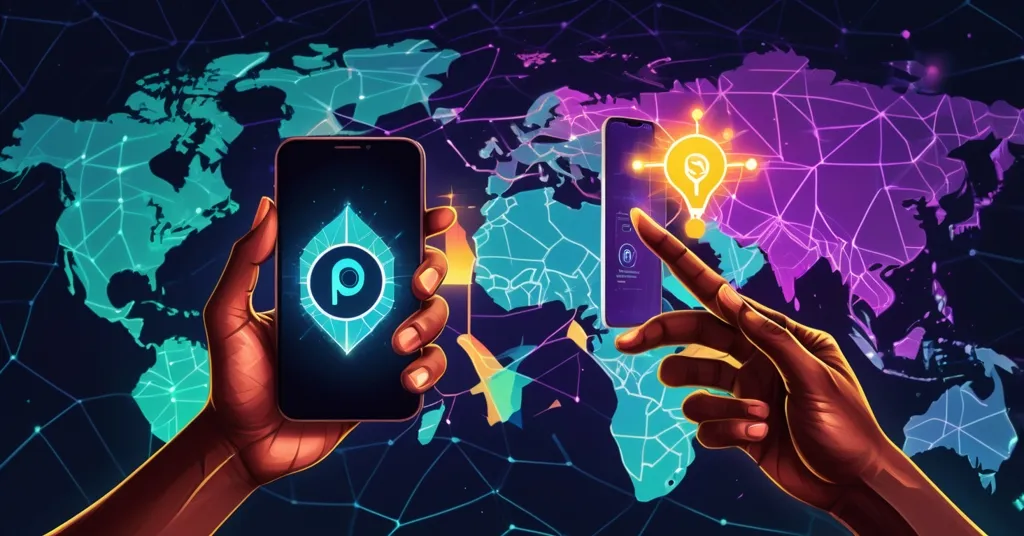India-Brazil Tech Pact: UPI Adoption, Blockchain Potential, and Global South Digital Revolution

India-Brazil Tech Pact: UPI, Blockchain Potential, and Digital Payments in the Global South
India and Brazil, two heavyweights of the BRICS coalition, have struck a historic agreement to supercharge collaboration in digital public infrastructure (DPI), artificial intelligence (AI), and other frontier technologies. Sealed during Prime Minister Narendra Modi’s recent state visit to Brazil at the invitation of President Luiz Inácio Lula da Silva, this partnership promises to reshape public services and drive national development through shared tech innovation, with a spotlight on Brazil’s potential adoption of India’s Unified Payments Interface (UPI).
- Tech Alliance: India and Brazil join forces on DPI, AI, and cutting-edge innovations.
- UPI in Brazil: Brazil eyes India’s real-time payment system to enhance financial inclusion.
- Trade Ambition: Bilateral trade targeted to hit $20 billion in five years.
This deal is more than a bilateral handshake; it’s a potential game-changer for the Global South, aligning with the BRICS Digital Economy Framework and Sustainable Development Goals (SDGs). As champions of digital sovereignty, both nations are carving a path to challenge Western-dominated tech and financial systems. From digital payments to speculative blockchain tie-ins, let’s break down the nuances of this partnership, weigh the optimism against the risks, and see where it fits in the crypto and decentralization narrative.
Digital Payments Revolution: UPI Meets Pix
At the core of this alliance is the exchange of expertise in digital payments. India’s Unified Payments Interface (UPI), launched in 2016 by the National Payments Corporation of India (NPCI), enables real-time, near-zero-cost transactions via mobile devices. It dominates over 75% of India’s retail digital payments, bringing millions of unbanked individuals into the formal economy—think street vendors now accepting payments via QR codes. Brazil’s Pix, introduced in 2020 by its Central Bank, is no slouch either, clocking 15.4 billion quarterly transactions by mid-2024 and earning the title of the world’s fastest-adopted payment system. It’s already empowered small businesses and unbanked citizens across Brazil’s sprawling favelas.
Now, Brazil is keen to integrate UPI, seeing it as a complementary boost to Pix for financial inclusion. As Modi stated during the visit:
“Both sides are also working together on the adoption of UPI in Brazil. We would be glad to share India’s successful experience with Brazil in areas such as Digital Public Infrastructure and Space.”
Raj Kapoor, founder of the India Blockchain Alliance, sees immediate upside:
“The [UPI] adoption would immediately offer Brazil a transformative opportunity to accelerate financial inclusion, digitize its economy further, and improve public service delivery.”
But let’s cut the hype. UPI’s rise in India wasn’t instant—it took shocks like the 2016 demonetization and the COVID-19 cash-averse panic to hit critical mass. Pix, while a juggernaut, hasn’t obliterated traditional finance; credit card usage in Brazil has surged post-Pix with a compound annual growth rate (CAGR) of 31.7%. In India, it’s up 24.2% since 2020. Disruption? Sure. Total overhaul? Not quite. And then there’s the ugly side: fraud. Scammers are the cockroaches of the digital world—UPI users in India have lost tens of thousands of rupees to phishing schemes, like fake buyers on marketplace apps. Pix faces similar exploits. If Brazil imports UPI without bulletproof security, it’s like handing fraudsters a blank check. For more on the security and scalability challenges of UPI and Pix, the discussion offers valuable insights.
AI and Emerging Tech: Beyond Payments
The partnership extends into AI, quantum computing, and space technology. Brazil offers strengths in biometric banking and geospatial datasets—think agricultural and climate science data—that could turbocharge India’s AI models, especially for multilingual applications. Kapoor highlighted this synergy:
“Access to Brazil’s diverse datasets, particularly in agriculture and climate sciences, can enhance India’s AI training capabilities, especially in multilingual contexts.”
India, meanwhile, shares platforms like CoWIN (a digital health tracking tool) and ONDC (an open e-commerce network), alongside its leadership in ethical AI, with Brazil endorsing India’s role at the AI Summit in February 2026. Modi underscored the broader vision:
“We have set a goal to raise bilateral trade to 20 billion dollars over the next five years…Our collaboration in the fields of artificial intelligence and supercomputers is expanding. This reflects our shared vision for inclusive development and human-centric innovation.”
While exciting, let’s not overplay this. AI and quantum tech—think ultra-fast computing based on quantum mechanics—sound futuristic, but their immediate impact on public services remains vague. For our focus, the real question is whether these innovations could intersect with blockchain, perhaps in securing smart contracts or tackling quantum threats to crypto encryption.
Data Security and Sovereignty: A Tightrope Walk
Data protection forms a critical pillar of this alliance. India’s Data Empowerment and Protection Architecture (DEPA) and Brazil’s General Data Protection Law (LGPD) aim to ensure secure cross-border data flows. This matters in a world of rampant cyber threats—think massive breaches that expose personal info. But adopting foreign tech like UPI raises red flags about digital sovereignty, or a nation’s control over its own digital tools and data. It’s like owning your house versus renting—relying too much on another country’s system risks losing autonomy. History shows this isn’t theoretical; look at how some nations struggled with over-dependence on foreign telecom gear, facing security backdoors.
Brazil’s past actions add another layer. Its Central Bank has blocked big tech moves—like halting WhatsApp’s payment launch in 2020—to protect local fintechs, while India embraces giants like Google Pay, which control over 80% of UPI transactions. Will UPI in Brazil be a straight import or a hybrid under tight local control? The answer could shape whether this partnership truly empowers or just shifts dependencies. For deeper insights into UPI adoption discussions in Brazil, online forums provide a raw perspective.
Blockchain and Crypto: The Unspoken Potential
While not explicitly mentioned in the agreement, blockchain looms large as a potential linchpin for this tech alliance. Its ability to provide transparent, tamper-proof records aligns perfectly with goals of secure data exchanges and digital sovereignty. Imagine UPI or Pix transactions logged on a decentralized ledger—scammers would have a much harder time faking payments. Cross-border data sharing under DEPA and LGPD could also benefit from blockchain’s security, ensuring health or financial records aren’t manipulated mid-transfer. The India-Brazil tech partnership’s potential in digital payments and blockchain offers a glimpse into these possibilities.
For the crypto crowd, this pact opens tantalizing doors. Financial inclusion via UPI and Pix creates fertile ground for decentralized finance (DeFi) and cryptocurrency adoption, especially in the Global South where trust in centralized systems often falters. The BRICS push for de-dollarization—reducing reliance on the US dollar for trade—adds fuel. Could we see a future where cross-border settlements within BRICS pivot to digital currencies, be it central bank digital currencies (CBDCs) or stablecoins on altcoin networks? Bitcoin, as a neutral, decentralized reserve asset, could play a role here for trustless value transfer, though altcoins and Ethereum-based solutions might offer more practical short-term tools for DeFi integration.
Real-world examples back this speculation. Blockchain already powers some cross-border remittances—think RippleNet or Stellar—cutting costs and time compared to SWIFT. BRICS nations have discussed alternative payment systems in past summits, hinting at openness to non-traditional finance. But don’t pop the champagne yet. Regulatory chaos across BRICS, plus cybersecurity nightmares (like India’s CoinDCX hack), could derail any crypto dreams without ironclad frameworks. Centralized oversight of UPI and Pix also clashes with pure decentralization ideals. Still, the ethos of empowering local economies through tech mirrors crypto’s core mission.
Challenges and Risks: Keeping It Real
Let’s not sugarcoat the hurdles. Beyond fraud, infrastructure gaps in rural India and Brazil could slow tech rollout—fancy apps mean nothing without reliable internet. Regulatory lag is another beast; BRICS nations often move at a snail’s pace to harmonize policies, and digital payment rules differ wildly. Then there’s the geopolitical angle: Brazil and India pushing tech influence via forums like the G20 sounds great, but clashing interests within BRICS (looking at you, China) could stall progress. A closer look at UPI adoption details and financial inclusion impacts sheds light on these challenges.
Cybersecurity remains the elephant in the room. A real case from India drives this home—a user lost ₹50,000 to a scammer posing as a buyer on a marketplace app, exploiting UPI’s ease of use. Pix has sparked similar scams. Brazil adopting UPI without tailored safeguards is rolling the dice. On the flip side, strong data laws like LGPD and India’s open-source approach to DPI offer a starting point to mitigate risks. Customization, not blind adoption, is key. Discussions on how Brazil could benefit from India’s UPI system highlight potential advantages and pitfalls.
Modi framed the global stakes powerfully:
“At the global level, India and Brazil have always worked in close coordination. As two major democracies, our cooperation is not only relevant to the Global South, but also to all of humanity. We firmly believe that it is our moral responsibility to bring the concerns and priorities of the Global South to the forefront of the global stage.”
Kapoor echoed the strategic weight:
“The India–Brazil MoU is a strategic bilateral agreement that shall set a blueprint for reshaping digital cooperation across the Global South. By combining India’s scalable, people-centric digital infrastructure with Brazil’s ecosystem and regional leadership, this partnership has the potential to redefine how emerging markets deploy technology for inclusive, sustainable development.”
Key Questions and Takeaways
- How does the India-Brazil tech alliance impact global digital payments?
It could pioneer interoperable systems like UPI and Pix across BRICS, easing cross-border trade and remittances while offering a scalable model to bypass traditional financial gatekeepers. - What role might blockchain play in this partnership?
Blockchain’s transparency and security could underpin DPI tools and cross-border data flows, protecting transactions and records under frameworks like DEPA and LGPD from fraud or tampering. - Could this collaboration boost cryptocurrency adoption in the Global South?
By prioritizing financial inclusion, it sets the stage for DeFi and crypto as alternatives to centralized systems, though regulatory inconsistencies and cyber risks could slow the pace. - What risks come with Brazil adopting India’s UPI?
Cybersecurity threats and loss of digital autonomy are major concerns, but tailoring UPI to local needs with robust data laws like LGPD could address these pitfalls. - Does this align with decentralization principles in the crypto space?
The focus on inclusive tech and sovereignty echoes decentralization’s spirit, potentially inspiring DeFi solutions, though centralized control of systems like UPI remains a sticking point.
This India-Brazil partnership is a bold middle finger to outdated financial systems and a nod to a future where the Global South sets its own tech agenda. From UPI’s potential to revolutionize Brazil’s economy to blockchain’s unspoken promise, the implications ripple far. Yet, the road is littered with traps—scammers don’t sleep, infrastructure lags, and tech isn’t a magic wand. Could this alliance spark a DeFi boom or challenge SWIFT with decentralized alternatives? Time—and tech—will tell. For now, it’s a step toward a financial revolution with freedom and privacy at its heart, especially when considering the similarities between UPI and Pix for financial inclusion in the Global South.



